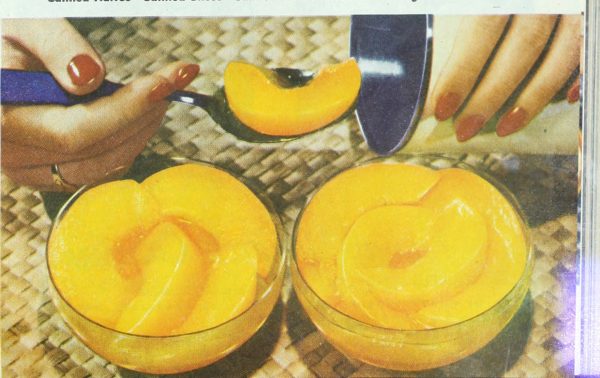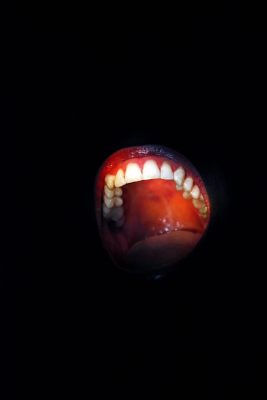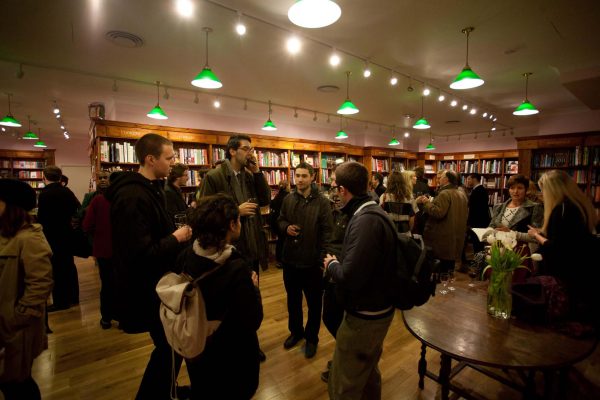The explosion happened one mid-morning at the Swan Custard Factory. A dust-cloud of cornstarch was ignited, blowing off the roof of the building, injuring nine workers and killing one. When the fire engines arrived, the water they used to put out the fire turned to custard when mixed with all the powder and heat. It flowed down the neighbouring streets, where it was eaten by pigeons and little children who ran out after it with tea cups to fill.
One unfortunate girl started to choke after drinking two cups of the liquid. Her father pounded her stomach until she threw up two human teeth, a fingernail and a blue stud earring shaped like a butterfly. These had belonged to Gloria-Jean Lewis, the one casualty of the explosion.
The owner of the factory was Alfred Swan III, grandson of the original Alfred Swan, a pharmacist who had invented instant egg-free custard powder after his wife had an allergic reaction at a dinner party. The original Alfred Swan and his wife were unsure which was the offending ingredient until she fainted and broke out in a rash a few days later after eating a boiled egg. No one knew what had caused her to suddenly be unable to stomach eggs. An untold part of the story, absent from the official histories of the custard company, is that she subsequently ate a whole jar of pickled eggs in an attempt to kill herself. She was found by her husband beside the empty jar, and was sent to an institution where staff were given strict instructions not to feed her any eggs, or place any eggs in her surroundings.
The custard powder made in Alfred Swan’s factory was simply cornstarch, yellow colouring and a little flavouring to make it look and taste a bit eggy. The instructions suggested it could be mixed with either milk or water. It was mainly sold in bulk to boarding schools where children were hit, and to little corner shops where it sat on dusty shelves, and was bought by old men who had gone to such schools, craving the desserts of childhood.
The air around the factory smelled sweet, as did the houses of the factory workers, their clothes and hair always covered in a light layer of custard dust. Most of the workers took extra custard powder home: the stuff they swept off the floors into paper bags, the batches that weren’t the exact shade of pale yellow for which the brand was famous.
The office of the custard factory was decorated with china swan figurines, and a large swan egg on a brass stand. There was a giant painting of the original Alfred Swan, but none of his wife. Her drawings of eggs were lost to time. The institution had closed down long ago.
Gloria-Jean, who was named after a 1950s actress she didn’t care for, had joined the factory when she was 21. She had long red hair she had to keep in a hairnet on shift, like something bloody caught in a spider’s web, and she was the only staff member who didn’t bring any custard home, because it gave her diarrhoea. She liked to read Shakespeare and Margaret Cavendish. There was a man, perhaps sixty or seventy years old, tall and stooped with wispy long white hair under a red baseball cap, who sat across from her every day while she ate her lunch in the staff canteen. He mixed whatever custard powder he had swept off the floors that morning into a cup of black tea (he had his own dainty, floral mug) and drank it with an absent smile on his face. Every day, he brought a sandwich: two slices of white bread that appeared to have nothing in between them.
Gloria-Jean eventually learned that there was a very thinly spread layer of mayonnaise inside. The man loved mayonnaise more than anything else in the word, and carefully rationed it day by day. Gloria-Jean ate rotten, wrinkly apples, brown grapes, cold baked beans she spooned straight from the can, uncooked noodles from Chinese supermarkets, raw potatoes, boxes of cream biscuits. She didn’t like to cook. She only liked what she vaguely called her Mind’s Work, which involved reading lots of public library books, looking at old things in second-hand shops and occasionally seeing a movie if it met certain mysterious criteria she couldn’t explain.
One lunchtime, the old man passed her a cracked black-and-white photo he kept in a plastic Ziploc bag. It showed a young soldier in uniform, with light curls, a handsome face and many medals on his chest. The old man pointed at the photograph, then pointed at his own chest. He undid the first few buttons of his Swan Custard Factory uniform (a peach-coloured boiler suit with a tiny swan embroidered on the front pocket) to reveal a sweatshirt with the same medals — the ribbons wrinkled — pinned to his chest.
After work, he took her to a diner called the Café Mars. He ordered a blueberry muffin, and Gloria-Jean a plate of French fries. He eyed the little container of mayonnaise they gave her on the side, and she pushed it over to him. He spread it on his muffin. His name, he told her, was Wilfred Lewis.
Wilfred Lewis lived in a large brick house, painted pink. The yard was wild with roses and gnome figurines who had lost their shine and stood sadly like shrunken and bloated Greek statues. It was the house he was born in, and where he had lived, after the war, with his mother, until she died. The house did not have a washing machine or a fridge or any other modern appliances, though it had a fancy wooden and metal ice box, a toilet with a pull chain and an odd sort of bathtub with panelling around it, cracked with black mould.
There were lots of old and interesting things to admire in the house: hat boxes, very old rusted mousetraps, children’s books about rag dolls and mermaids, china and porcelain figurines shaped like animals. Gloria-Jean thought the house contained a china figurine for every animal in the world — even the extinct ones, for she found a Dodo. ‘There are lots of old things for me to sort through and entertain myself with,’ she thought. ‘That and the public library should keep me with things to do.’ And so she moved in with Wilfred Lewis, and later married him, so she would have some claim to the house.
She took Wilfred’s mother’s old room, which was the largest, with floral-print wallpaper and cupboards full of old cotton nighties. Wilfred continued to sleep in the room he’d always slept in, his old soldier’s uniform and other war essentials in a suitcase under his bed. The only modern addition to the room was a poster of Garfield.
Gloria-Jean kept all of her books in a locked suitcase in her room. She did not want Wilfred to read them, or to look at the covers.
She took Wilfred Lewis’s photograph from him, removed it from its plastic bag and put it in an elaborate silver frame she had bought at an antique shop. She placed it on her nightstand. She never looked at it, but she no longer wanted him to have it, in case he might show it to other young women, in delis, grocery stores and at the park. She could tell Wilfred Lewis was displeased when she took the photograph from him, but he did not try to take it back.
In addition to her books and a few flimsy white polyester dresses she wore when not in her work uniform, Gloria-Jean brought an oil painting of her great-grandfather wearing a fur hat and the blue military uniform of a country which no longer existed. In order to get the painting out of his country Gloria-Jean’s grandfather had hidden it under his coat, pressed up against his back, padded with cloth. He pretended to be a hunchback. Because of this, they were eligible for a charitable fund from a church in their new country, but it meant that her grandfather had to wear the painting and the padded cloth under his coat whenever he left the house, in case the church people saw him. Over the years the painting became damaged from being worn outside so often, and from the nervous sweat of Gloria-Jean’s grandfather.
Gloria-Jean and Wilfred Lewis had three children: Geoffrey, Ambrosia and Simon. Gloria-Jean named the first, Geoffrey, after a character from a novel she loved, but left the naming of the other two to Wilfred: she realised it was a mistake to name her children after beloved characters in fiction. Ambrosia was a competing custard brand to Swan’s, and Gloria-Jean wept at Wilfred’s lack of imagination.
Wilfred bought a television for the children on which they watched The Neverending Story, Peter Pan, multiple versions of Robin Hood, and a film called The Last Unicorn which made Wilfred cry. Gloria-Jean would never sit down to watch television with her family, but sometimes she would stand at the door of the living room and watch snippets of the movie, then disappear.
Wilfred Lewis cooked for the children: custard with sliced hot dogs or pieces of grapes and melon, mayonnaise and sliced cheese sandwiches, macaroni with custard baked with potato chips on top. He took them to unpleasant zoos where tigers were kept in small cages, to the cinema for popular children’s movies, to amusement parks. He bought them bags of plastic dinosaurs, guns and baby dolls.
Gloria-Jean lost interest in the children when one after the other cried when she put an interesting Victorian toy she’d found in some crevice of the house in their faces — a dusty monkey with no eyes holding a drum, a doll whose pink skin was cracked, a story book about goblins. The only objects of their grandmother’s they liked were the animal figurines, many of which became chipped from being boisterously played with. Gloria-Jean carefully put them back together with glue. This activity, which required a lot of squinting, along with her reading, led her to need glasses.
After they graduated from school, all three children got jobs at the Swan Custard factory and continued to live at home.
Geoffrey was the shortest, and Simon the tallest, which could only be put down to an improvement in school lunches, because the Lewis family always ate the same things, and did not change their habits much. They took to keeping many cats, which they fed with custard powder mixed with cold milk and kibble. To the family they were known as Whiskers, Pussy, Marmalade and Tiger, but Gloria-Jean had secret names for the cats, derived from botany books and Elizabethan drama, which she’d whisper in their ears when they slept on her bed. Sometimes she’d buy them the sweets she never bought for her children. One cat died from eating a chocolate bar, though she did not know that this was the cause of its death.
Geoffrey and Ambrosia had red hair like their mother, while Simon looked exactly like Wilfred Lewis.
When he became a teenager, Geoffrey dyed his hair black, pierced his own nose, putting a small gold earring of his mother’s through it, and gave himself tattoos using a ballpoint pen and a razor. Wilfred Lewis liked to play baseball, and collected baseball cards. There was a type of children’s chewing gum which imitated the chewing tobacco which famous baseball players consumed, and this was the only thing Simon liked to eat. He did not know that he wasn’t supposed to swallow gum.
Ambrosia admired the swan egg in the factory office and wanted one just like it. Alfred Swan made a deal with her that if she slept with him she could have it. He spent a long time moving his fingers around inside of her as if he had lost something like a coin in her body. He did it so forcefully the whole room rattled and Ambrosia worried the Swan egg would break. That was all he did. He cleaned his hand very carefully afterwards with a tissue and asked her if it had given her any pleasure. She said no, and took the swan egg off its brass stand.
She put it in her knapsack and finished her shift. By the time she was home, the egg had cracked into pieces. It must have been bumped by her co-workers in the locker-room, gathering their things or changing out of their uniform.
She went into her mother’s room, where Gloria-Jean spent her free hours reading with a hot water bottle under her head, and asked her mother to fix the egg. Gloria-Jean took the pieces from her daughter and stared at them, knowing something dreadful and dramatic had happened.
Soon afterwards, Alfred Swan had installed a new swan egg in the exact same place, and Ambrosia realised that the precious object was not unique, though she did not know where to get one herself. Gloria-Jean saw the new egg too, and shivered with a vision of the future: a long line of broken swan eggs brought to her by her daughter, for her to piece together with glue.
Gloria-Jean resolved to set something in Alfred Swan’s office on fire. She bought a plastic lighter from a convenience store. It was purple, with the outline of a Ninja Turtle imprinted on it. In an idle moment, wondering how a swan egg burned, she flicked it on and off when she was supposed to be sweeping the factory floor.
Once they were released from hospital, Geoffrey, Ambrosia, Wilfred Lewis and Simon all had to wear cloth bandages that they were required to change regularly. A burn of the degree they suffered does look like custard stuck to the skin. As the burns healed and dried, they peeled off the yellow skin and put it into a designated pot from which Wilfred Lewis shooed the cats away so they wouldn’t eat the skin scraps.
Ambrosia liked to stick their animal figurines in the ice box, and when they were cold enough, place them against her burns.




